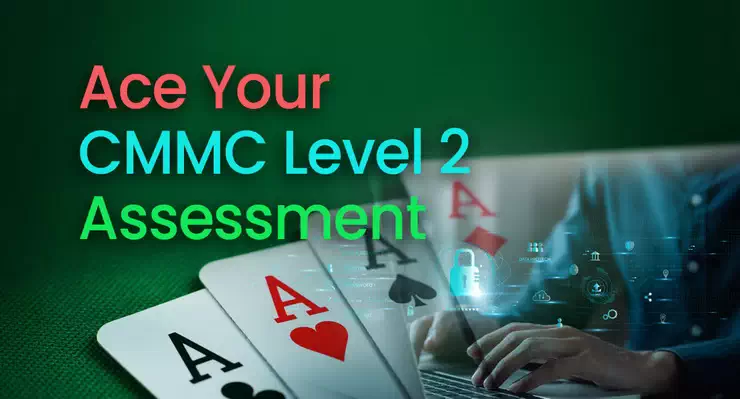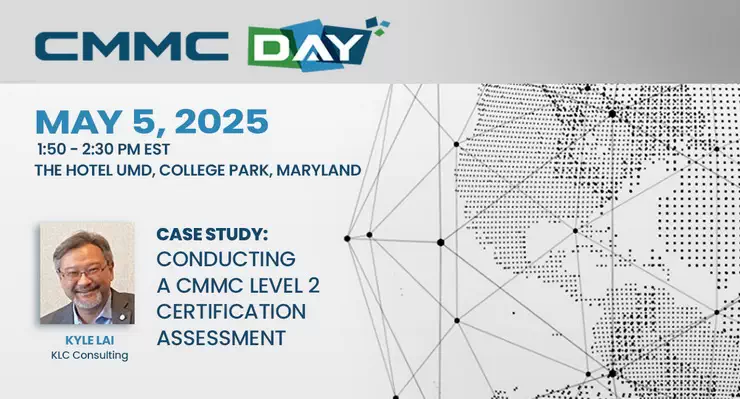
Introduction
The path to CMMC Level 2 Certification can seem daunting, but with the right guidance, it becomes a clear and achievable process. For DoD contractors, achieving CMMC Level 2 is not just a requirement; it’s a commitment to safeguarding sensitive information. This post distills insights from KLC Consulting’s March 2025 “Ask the Experts” webinar, addressing common questions and providing actionable guidance to confidently approach CMMC compliance.
Understanding the CMMC Level 2 Assessment Schedule
The CMMC assessment schedule is a crucial element in planning your Certification journey. A typical CMMC Level 2 Certification timeline, such as the one used by KLC Consulting, involves several carefully structured phases. These processes, grounded in the Cyber AB’s CMMC assessment process (CAP 2.0), provide a standardized approach to evaluating an organization’s cybersecurity maturity.
CMMC Level 2 Assessment: A Step-by-Step Process
The CMMC Level 2 assessment process is divided into distinct steps to ensure a thorough and accurate evaluation.
- CMMC Pre-Assessment Phase: The initial phase, the CMMC pre-assessment, typically spans about three weeks. During this period, the C3PAO, like KLC Consulting, gathers essential information, including the System Security Plan (SSP), scoping diagram, and CUI data flow. The goal is to ensure the Organization Seeking Certification (OSC) has a solid understanding of CUI, the environment, and the scope of the assessment. This CMMC pre-assessment phase sets the stage for a successful assessment.
- CMMC Level 2 Assessment Phase: The next phase involves the actual CMMC Level 2 assessment. Assessors send requirement artifacts to the OSC, who then provides the necessary documentation. This phase also includes logistical planning, especially for on-site assessments if physical CUI is involved. The assessment week is a critical period, with daily touchpoints between the assessors and the OSC to address any immediate needs or concerns.
- Report Generation and Certification: After the assessment, the C3PAO compiles the findings into an assessment report and conducts an out brief with the OSC. If all requirements are met, the CMMC certificate is issued. In cases where Plan of Action and Milestones (POA&Ms) are needed to address gaps, a conditional Certification is granted, allowing 180 days to rectify deficiencies.
It’s vital to note that adherence to these certification timelines, as prescribed by the CMMC program, is essential for a smooth and successful CMMC Level 2 assessment.
CMMC Level 2 Assessment Costs
A common question among organizations seeking CMMC Level 2 Certification is, “How much does a CMMC Level 2 assessment cost?” The cost of a CMMC Level 2 assessment is not fixed and varies based on several factors. These factors include the size and complexity of your organization, the number of locations, and the involvement of Managed Service Providers (MSPs) or Cloud Service Providers (CSPs). The number of CAGE codes in scope also influences the overall cost of the CMMC assessment. To get an accurate estimate, it’s recommended to request a quote from an authorized C3PAO.
Finding Reliable CMMC Resources
Navigating the world of CMMC requires access to reliable resources. Where can you find accurate information on CMMC documentation, C3PAOs, and CMMC consultants? The DoD CIO website serves as the official source for CMMC program information, including assessment guides and scoping guidance. The Cyber AB Marketplace is another invaluable resource, providing a vetted list of Registered Practitioners, Certified Professionals, Certified Assessors, and authorized C3PAOs. Additionally, reputable consulting firms often provide valuable resources, blogs, and knowledge bases on their websites.
Understanding Cloud Service Providers (CSPs) in CMMC
The definition of a Cloud Service Provider (CSP) within the CMMC framework can be nuanced. According to 32 CFR 170.17(c)(2), the definition aligns with NIST 800-145. A key characteristic of a CSP is “on-demand” access to computing resources. This implies a high degree of automation and self-service. It’s important to distinguish between services that are truly on-demand and those that require significant manual intervention or setup. Understanding these distinctions is crucial for OSCs when determining the scope of their CMMC Level 2 assessment.
Operational Plan of Action, Enduring Exceptions, and Temporary Deficiencies
To effectively navigate the CMMC Level 2 assessment, it’s important to understand some key terminology:
- Operational Plan of Action: This refers to a documented plan to address vulnerabilities or temporary deficiencies in implemented controls. It’s different from a POA&M, as it applies to already implemented controls.
- Enduring Exceptions: These are specific situations where a vulnerability cannot be remediated, often due to technical limitations (e.g., legacy equipment with Certifications).
- Temporary Deficiencies: These are short-term gaps that are actively being addressed through an Operational Plan of Action.
CMMC Program Updates and the Trump Administration
Organizations seeking CMMC Level 2 Certification often express concerns about the impact of political changes on the CMMC program. Changes in administration can sometimes lead to reviews or delays in government programs. However, it’s important to stay informed about the latest developments and agency statements regarding the CMMC program’s future.
CMMC Certification Assessment Timeline
The question “How long does a CMMC Certification assessment take?” is a common one. While a typical timeline exists, the actual duration can vary. Factors influencing the CMMC Level 2 assessment timeline include the OSC’s preparedness, the organization of provided artifacts, and the availability of personnel for interviews. Efficient organization and clear presentation of documentation can significantly contribute to a smoother and faster assessment.
Using GRC Tools for CMMC Assessment
Many organizations utilize Governance, Risk, and Compliance (GRC) tools to manage their CMMC documentation. While GRC tools can be beneficial for OSCs, C3PAOs may still require the export of artifacts for the assessment process. This is partly due to the need for artifact hashing, which ensures the integrity of the reviewed documentation. It’s important to clarify with your C3PAO how they prefer to interact with your GRC tool.
CMMC Assessment Artifact Requirements
Providing the right artifacts is crucial for a successful CMMC Level 2 assessment. Common artifacts include the System Security Plan (SSP), policies, procedures, and screenshots demonstrating control implementation. These artifacts provide evidence that the OSC is effectively meeting the security requirements.
CMMC Assessor Expectations for Artifacts
CMMC assessors carefully examine the provided artifacts to verify both the definition and implementation of security controls. This involves reviewing policies, procedures, and evidence of implementation, such as system configurations and logs. Assessors need to see not only that a control is defined but also that it’s consistently and effectively applied within the organization.
Factors for a Smooth CMMC Assessment
Proactive preparation and attention to detail can significantly streamline the assessment. Several factors contribute to a smooth CMMC Level 2 assessment. These include:
- Clear and organized presentation of artifacts
- Effective change management processes
- Accurate system configuration and time synchronization
- Preparedness of OSC personnel for interviews
What CMMC Assessors Do On-Site
On-site assessments involve the C3PAO assessing specific controls, particularly those related to physical security and media protection. Assessors may review practices related to USB usage, media labeling, and document shredding. These on-site activities are a critical component of the overall CMMC Level 2 Certification assessment.
Common Issues in CMMC Assessments
OSCs sometimes encounter common issues during CMMC assessments. Addressing potential pitfalls proactively can improve the likelihood of a successful assessment. These can include:
- Version control inconsistencies in documentation
- Discrepancies between architectural diagrams and actual configurations
- Inconsistent application of configuration management processes
- Inadequate training programs that don’t address specific organizational risks
CMMC and FIPS Encryption
There’s often a question about whether FIPS encryption removes data from CUI categorization. It’s important to clarify that FIPS-encrypted CUI is still considered CUI. This clarification is vital for proper handling and protection of this information.
CMMC Re-evaluation of Assessment Objectives
In situations where deficiencies are identified, there might be an opportunity for re-evaluation. However, this is subject to specific conditions, such as providing additional evidence and ensuring that the re-evaluated controls don’t impact other requirements.
CMMC Enduring Exceptions
Enduring exceptions are specific cases where a requirement cannot be met due to legitimate constraints. These exceptions require careful documentation and justification and are evaluated on a case-by-case basis.
Time Stamping CMMC Evidence
While time stamping evidence isn’t always mandatory, providing current and relevant artifacts is essential. For policies and procedures, version control and approval dates are important.
C3PAO Assessment Environment
C3PAOs conduct assessments within their own secure, authorized environments to protect the confidentiality and integrity of the assessment data.
CMMC, False Claims Act, and SPRS Submissions
Organizations must be truthful and accurate in their self-assessments and when reporting their CMMC implementation status. Providing inaccurate information can have legal ramifications.
Detailing CMMC Policies and Procedures
The level of detail required for policies and procedures can vary. The key is to ensure they adequately cover the CMMC requirements and demonstrate how the organization meets those requirements.
Ready to Begin Your CMMC Level 2 Certification Assessment?
The CMMC Level 2 Certification assessment requires a thorough understanding of the process, diligent preparation, and access to reliable information. C3PAOs like KLC Consulting, Inc. are partners in this process, committed to helping organizations protect sensitive information and meet their contractual obligations. Download our free CMMC Level 2 Readiness Checklist to prepare for your assessment. Contact us to schedule your assessment and ensure your organization is prepared for the evolving cybersecurity landscape.



